The Joy of PizzaEverything You Need to Know
Learn to make artisan pizza the American way in this accessible, informative guide to the perfect pie from the creator of “the best pizza in New York” (New York Times).
Pizza is simple: dough, sauce, cheese, toppings. But inside these ordinary ingredients lies a world of extraordinary possibility. With The Joy of Pizza, you’ll make the best pizza of your life.
Dan Richer has devoted his career to discovering the secrets to a transcendent pie. The pizza at his restaurant, Razza, is among the best one can eat in the United States, if not the world. Now, Richer shares all he has learned about baking pizza with a crisp, caramelized rim; a delicate, floral-scented crumb; and a luscious combination of sauce, cheese, and toppings that gets as close to perfection as any mortal may dare.
You’ll learn how to make Razza specialties such as:
- Jersey Margherita, a new classic improving on Neapolitan tradition with
- Meatball Pizza, the first time Richer has shared the recipe for Razza’s legendary meatballs
- Project Hazelnut, pairing the rich flavor of the nuts with honey and mozzarella
- Santo, topped with caramelized fennel sausage and drizzled with chile oil
- Pumpkin Pie, a cold-weather pie with roasted pumpkin, ricotta salata, and caramelized onions
- And many more inventive and seasonal pizzas, from Funghi (mushroom) and Montagna (arugula and speck) to Bianca (white pizza) and Rossa (vegan tomato pie)
Suited to beginning home bakers and professionals alike, these crusts begin with store-bought yeast as well as sourdough starter. Richer shows how to achieve top results in ordinary home ovens as well as high-temperature ovens such as the Ooni and Roccbox, and even wood-fired outdoor pizza ovens.
The Joy of Pizza is rich with step-by-step photography, links to instructional videos, and portraits of every pizza before and after it meets the heat of the oven—so you’ll know exactly what to do to create superior results.
The ingredients are simple. The methods are straightforward. And the results are deliriously delicious.
Dan Richer is the chef and owner of Razza in Jersey City. A graduate of Rutgers University, he skipped his own graduation to fly to Italy and begin his real education: in pizza. He is a four-time semifinalist for the James Beard Foundation’s Best Chef: Mid-Atlantic award, as well as a James Beard Rising Star Chef semifinalist.
Katie Parla is an Italy-based food and beverage writer, culinary guide, educator, and award-winning cookbook author. She is the cohost of the Gola podcast about Italian food and culture and regularly appears as an Italy expert on CNN, the Travel Channel, and the History Channel. She has lived in Rome since 2003, and Razza Pizza.
Dan Richer
Dan Richer went to Italy and ate a bowl of pasta and as a result he wound up on the New York Times Bestseller list but not for pasta. There were a few steps in between. Such as developing a love for Italian food and pizza in particular. Then there was the restaurant Razza Pizza Artigianale that he opened up and at the same time developing his own personal philosophy and rules for pizza. And somewhere in there he found the time to write a book that landed itself (and him) onto the New York Times Bestseller list.
~~~~~~~
Booksaboutfood.com (BAF): When I saw the title of your book, The Joy of Pizza, in some ways it seemed a little obvious, because doesn’t pizza just generally give joy?
Dan Richer: Yeah.
BAF: Just when you see ‘pizza’, you think, “joy”. I’m happy.
Dan Richer: Very obvious.
BAF: Congratulations on the book doing so well. You’re a New York Times Bestseller.
Dan Richer: Yeah, thank you.
BAF: That must be exciting.
Dan Richer: Special. Unexpected.
BAF: I don’t think you go into pizza thinking you’re going to be a New York Times bestseller author, but that’s terrific, so congratulations on that. I guess, you are clearly very passionate about it and enthusiastic about the subject. So, how did all this come about? Did you have a moment of inspiration, when you got hit in the head with a pizza, so to speak?
Dan Richer: Yeah, there were a bunch of moments. First, obviously, it started in childhood, like most people’s love for pizza. And then I went to Rutgers. I started at their agricultural school, but I didn’t want to have anything to do with agriculture, so after three years I transferred out, within Rutgers, and got a degree in communication. Skipped my graduation ceremony to fly to Italy. It wasn’t necessarily the pizza that blew me away, it was the pasta. Something as simple as pasta with tomato sauce was so much better than anything I tasted all of my life, so I was just curious as to why and how. So, I started cooking at that moment and I haven’t stopped since then. I bought a failing restaurant in 2006, when I was 26, and it happened to have two wood-fired ovens and made really bad pizza. So I started learning about wood-fired ovens and pizza, and I just one thing at a time I picked apart the pizza down to the cellular level in order to put it together in a way that would create happiness for our guests.
BAF: So you flew to Italy, but it sounds like you didn’t have a culinary agenda. You were just off Italy, I guess.
Dan Richer: Yeah. My cousin was studying architecture in Rome and he had a two week break, so I flew over just to have an adventure. I had been working in restaurants since I was 15. My first job was as a busboy. And then at 17 I became a waiter. I’d made ice cream in college, and then started managing restaurants. So, I was in the restaurant business when I first flew to Italy and I always had my eyes on the kitchen. I always loved watching their process from raw materials to finish product. I always had my eyes in the kitchen, but it wasn’t until that Italy trip that I really just dove right in and started cooking immediately. I started going to farmer’s markets to buy ingredients, and that’s when I started talking farmers. And that’s when the agricultural background came in, because I could have intelligent conversations with a farmer about their process and their products. Agriculture is central to what I do with pizza, because ultimately pizza is an agricultural product. The dough starts with a field of wheat, and tomatoes are grown in a field, and cheese starts with a cow grazing on grass.
BAF: I noticed on your menu, regarding the agriculture, you do something which I think is really cool. You have the Margherita, then you have the Jersey Margherita. I thought that was terrific.
Dan Richer: Yeah. We actually have about five different versions of the Margherita pizza that we’ll cycle through, throughout the year. Because if you change one element of it, it changes the entire pizza.
BAF: I love the fact its the Jersey it’s Jersey cheese, Jersey tomatoes. It must be very interesting for people to come in and try one then try the other.
Dan Richer: Side by side.
BAF: Must be fun for you to see their reactions.
Dan Richer:I think it’s extraordinary. We do this with wines. We’ll have two different glasses of red wine that are made from the exact same, not the exact same, but they’re both made with grapes, and grapes alone. But the characteristics between the two wines can be completely, completely different based on the details, where it’s grown, how it’s grown, how it’s fermented, and how it’s treated. So why not apply that to pizza, and specifically the Margherita where the fundamentals are the same, but the details are completely different. It leads to a very interesting dialogue, and very interesting eating experience, because they are completely different, but they’re the same.
BAF: So I get to experience really what Jersey’s all about, and it gets really a bad reputation, because people see it from the west side of Manhattan and they think, “Okay, that’s Jersey,” and they sort of laugh at the Garden State motto, but there is a lot, agriculturally, that Jersey has to offer. I like the fact that you are promoting something which people often overlook and don’t appreciate.
Dan Richer: Yeah, without a doubt. We are the Garden State. We have a diminishing quantity of farms, but our goal is to promote it so that new farms pop up, and small farms that are still truly invested in it survive and thrive, because agricultural systems are so important to a local economy and to our local food supply that if they don’t thrive, and if they sell their land to a developer who puts a housing development, we lose our food system.
If you taste a carrot that’s grown in really good soil, a very specific variety of carrot, and it’s freshly dug, and you compare that to something that you can buy at a supermarket, it’s a no brainer. It’s very obvious which one is more delicious. It probably has more nutrients in it. And it’s just a better experience. It’s really important to me, because ultimately all food is ingredients and technique. The way to make really delicious food is to focus on the raw materials and the techniques that we use to treat that raw material.
BAF: No, absolutely. It’s respect for everything involved. It’s often overlooked these days, but that sounds like it’s clearly something close to your heart in the restaurant, that you seek out these fine ingredients, or these unique ingredients, or locally, which-
Dan Richer: Yeah. And that’s the fun for me, is to meet a new grower, or a new cheese maker, and work with them to the point where they’re selling a great product and we get to promote them in a way that that helps their business thrive. And ultimately, we get a better pizza out of it.
BAF: It’s win-win, and certainly an important cause. Well, maybe I get a little philosophical here. Is there such a thing as the perfect pizza? Is that something that, you know, the platonic version of the iconic, perfect image of something. You, as a craftsman or an artisan, is this something you’re always striving for? Do you ever achieve it?
Dan Richer: No. There is no such thing as the perfect pizza. I’ve broken it down to very… 56 points about pizza that we’re trying to create every day. We do have a vision for what we’re trying to produce, but it could always be better. We can always extract more flavor out of the wheat. The cheese could always melt just a little bit nicer. The bake could be just a little bit more productive. We’re always shooting for it to be better today than it was yesterday.
BAF: I guess that’s one of the pitfalls of being an artisan, there’s always one more thing that you’re always thinking of, ahead or behind even, what could we have tweaked?
Dan Richer: And that’s part of the joy of it, is that it is a journey. We’re always learning new things. We’re always trying new techniques. We’re trying new products, whether it’s a new flour, or a new piece of equipment. We’re always just trying to make it more delicious, and trying to learn something along the way.
BAF: Was it hard to step out of the kitchen and encompass this enthusiasm, and this search, and your knowledge, into a book? Onto paper?
Dan Richer: I partnered with an amazing co-author, Katie Parla, and she was able to extract 20 years of pizza making and all of my thoughts on every minute detail. She just did a fantastic job. Without her, this book would not be a thing.
BAF: Sounds in some way almost like a therapy session, where she extracts the important parts, and maybe you can build on them. Say, “Oh, I never thought of that,” and go back and try something different.
Dan Richer: Definitely, definitely. It definitely opened up my eyes to a lot of the things that we are doing and things that, “Oh, maybe I can try this. Maybe I can try that.”
BAF: Now pizza is something that there’s a lot of argument about, tradition, non-tradition, and certainly you’ve got some very creative things on your menu. Pineapple pizza is always held up as being the big no-no, but-
Dan Richer: Very polarizing.
BAF: Yeah. Is pizza something that lends itself to this melange, or the fun of mixing things up a bit, and trying new things, and verging off, and into pineapple?
Dan Richer: Yeah, I think it does. We don’t do pineapple on a pizza, but-
BAF: No, should point that out.
Dan Richer: If I owned a pizzeria in Costa Rica or in Hawaii, where pineapples are a part of their agriculture, I would definitely put pineapple on a pizza, but to import an ingredient from thousands of miles away just because, that just doesn’t make sense to me.
BAF: Keeping with what you’re doing, with your general restaurant philosophy.
Dan Richer: Yeah, exactly. It’s very ingredient driven. We create pizzas based on ingredients that are here, with the understanding that the traditional element of pizza is very important. People’s views on pizza are very, very strong, and I try not to do anything too far out there that’s not going to be appreciated by a traditionalist.
BAF:I was going to ask, what sort of feedback… Talk about traditionalists, what sort of feedback have you gotten from people who’ve read the book and say, “Well, that’s not how we do it where my family comes from.” Have you gotten feedback from people saying, “That’s not really traditional,” or, “This needs to be more this”?
Dan Richer: Yeah. Especially with the dough recipes, the dough recipes are formulated specifically around the home oven. That’s one of the things that this book does differently, compared to all the other pizza books that have already been written. Most pizza books just take a restaurant recipe, or recipes geared around restaurant equipment, which bakes at a higher temperature. I kind of re-engineered, or reverse engineered, a dough specifically for the home oven, because people think, “Oh, you can’t really make restaurant quality pizza in your home oven.” I believe you can, you just have to alter your dough recipe from something geared around a restaurant oven and apply it to your home oven.
BAF: Yeah, that’s true. Most home ovens don’t go up to what, 800 degrees or something? If they do, it’s not a good thing.
Dan Richer: Yeah, no. The home oven maxes out at either 500 or 550, and typical pizzeria ovens are in the low 600s. Wood-fired ovens are certainly a little bit hotter.
BAF: Was that hard to do? You’ve got these wonderful recipes, was it hard to, as you said, reverse engineer for something the home cook could do?
Dan Richer: For me it wasn’t that difficult, because I had 18 or 19 years of pizza making experience, and I study the science in order to practice the craft. Because I have that scientific knowledge of it, it was a lot easier to create a product for the home oven.
BAF: Because that’s one thing that I, one of the many things I like about your book, was that it was focused on the home cook. Because as you said, a lot of places can write a great book, but you need a professional oven to pull it off.
Dan Richer: Exactly.
BAF: And so that’s-
Dan Richer: And these are professional level techniques, but it’s geared for the home cook, so it should push home cooks to be just a little bit better at it. It’s also for the professional. Any pizzeria owner should buy this book because you’re going to have a higher quality, more consistent product if you follow some of the skills.
BAF: Touching a bit on your bowl of pasta. It was pasta and tomato sauce, and you were blown away by it. I thought of the pizza, because it’s dough, and cheese, and sauce. Simple food is probably the hardest to do, because you have nowhere to hide.
Dan Richer: Yeah. Nothing to hide behind.
BAF: No, and your pizza is as a lot of great pizzas, it’s very simple, and straightforward, and no nonsense.
Dan Richer: Yeah. I always say that my four-year-old son should understand everything that we do. Pizza should not be this high-brow thing that you have to explain to people. All of our pizzas have a story behind it, and there’s a reason why we do each individual pizza, but you shouldn’t have to tell that story for someone to enjoy it.
BAF: That’s a good philosophy. It’s like a child should be able to pronounce all the ingredients in whatever he’s eating.
Dan Richer: Exactly.
BAF: It must be interesting for your regular clients, or customers, to come in, knowing that today the menu might be completely different in some way, or their regular pizza might have changed.
Dan Richer: Yeah. We work off of the 56 point evaluation rubric that’s in the book. That’s kind of our blueprint for our pizza at the restaurant. So, we’re always shooting for the same goal, because if you, as a guest, come in on Tuesday and on Saturday, it should be the same, if not better, pizza each time you come in. But we’re always shooting for the same goal, it’s the same target, but how we get there, and the flavors and textures that we can extract from it, can always be better.
BAF: Maybe I could just touch a bit, you mentioned the 56 points you work with. Maybe if you could just explain a little about that, if you wouldn’t mind.
Dan Richer: Yeah. It’s everything from the structural integrity of the pizza, like we should be able to pick up a slice of pizza up with our hands. It shouldn’t be soft, squishy, soggy, wet. It should have an audible crunch when you bite into it. The crust should shatter in your mouth, and not be difficult to chew through. The crust should be light, and airy, and aromatic on the inside. There’s eight points about tomatoes, from the sweetness of the tomatoes, to the acidity of the tomatoes, the color, the texture, if there’s seeds and skins in the tomato sauce. I really despise tomato skins in my pizza sauce.
BAF: I agree.
Dan Richer: They always get caught in your mouth, and it’s just an awkward experience. The cheese should melt in a certain way.
BAF: These 56, is this something you came up with on your own, or developed along your journey?
Dan Richer: Of course, yeah. It was developed over years, and I’m not opposed to adding or removing characteristics off of it. It’s been a work in progress for, I want to say, 16 or 17 years. It started, I think, as maybe six points about pizza that I wanted to create, and then I just kept adding to it over the years. And now it’s 56.
BAF: It almost sounds like a periodic chart, or a periodic table.
Dan Richer: Yeah. Yeah. But it’s really important for anyone who’s trying to create something, is to have goal, and to have a set of blueprints to work off of, because you can’t build a house with just boards, beams, and hammers and nails. You need to know what you’re trying to create, and then it’s that much easier to build it.
BAF: You’ve got the ingredients and what do you do with them? That’s the tricky part. Pizza in the New York-New Jersey area is probably one of the most contested things. There’s a pizza joint on every corner. Everybody has their favorite kind. I don’t know if it’s more of a statement than a question, but it seems that it’s very tricky waters to wade, because everybody’s going to have a different thought, like you mentioned about the book, everybody’s got a different view on it.
Dan Richer: Yeah. And that’s okay. Everybody can take a different opinion on an ingredient or how to put it together. That’s great. Variety is so special about life, and there’s none that are better or worse. You might have a favorite. Your pizza place might be your favorite, but it’s not necessarily better or worse than another place down the street. I just think it’s so interesting. It is difficult waters to wade through, but I take a pretty strong stance on all of our ingredients and techniques for pizza making, because I’ve been doing it for so long and every day we’re analyzing our work on a constant basis, both eating it and selling it. We’re just constantly trying to make it better.
BAF: I’m sure the taste testing must be fun.
Dan Richer: Always.
BAF: When you travel, do you always look for pizza places? I don’t know if you’ve been to Asia, if you find pizza there, or their version of it, or wherever. Like Scandinavia, or all over. You must enjoy-
Dan Richer: Yeah. I’m massively inspired by my travels. I love a good adventure, and usually I travel places that I want to explore their food culture, and pizzas definitely included in that. Depending on the type of trip that I’m on will determine how many pizzerias I go to, but travel to a place like Portland, Oregon, and they have so many world class pizzerias that you’d be missing it if you didn’t go to five different pizzerias. But yeah, I’m always inspired by my travels, and it might not even be to a specific pizzeria. I was having lunch in Italy on the side of Mount Vesuvius a few years ago, and we had this pasta dish that just… It blew my mind, so we took those flavors from the pasta dish and created a pizza around it.
BAF: Still on the menu?
Dan Richer: Still on the menu.
BAF: Oh, which one is that?
Dan Richer: This is the Di Natale. It’s a pasta dish that they only do around Christmas time and in the winter. It’s ingredients are all things that you would have during that time of year, which is dried fruit, dried nuts, olives that were cured. Things that were available, traditionally, in that area at that time of year. It’s fantastic.
BAF: That does sound interesting. Actually, can I ask, how do you… Sounds like you did okay, the restaurant wise, with everything going on. It sounds like you were able to weather the storm of this past year or so.
Dan Richer: Yeah. We were lucky. We made it through. We did a lot of construction in the restaurant. We put in a second pizza oven, which is no small feat, because we weren’t going to make it through the winter on takeout only out of one little, tiny pizza oven. We were able to adapt and change, and we’re in a good spot now, thankfully.
BAF: Good. Terrific.
Dan Richer: We also have really great landlords who were flexible with us.
BAF: Oh, good. That’s good to hear. It sounds like you were able to, I don’t want to say, take advantage, but use the situation in a positive way for you in the business, which is great…
Dan Richer: Definitely
BAF: So, you’ve written this book, and it sounds like you had a lot of fun doing it. What’s next?
Dan Richer: We’re expanding the footprint of the current restaurant. We’re about two weeks away from reopening that, so working on expanding the menu. We bought all kinds of new equipment, and new technology for the new space. I’m focusing on that for now, and then maybe I’ll write another book one day, who knows. Even since this book was sent to the printer, we’ve already changed our dough recipe three times, and we’ve created five or six new pizzas since then, so we’re still doing what we’re doing, which is growing, and learning, and changing and challenging ourselves, challenging our teammates, to just have more skills and knowledge.
~~~~~~~
Boksaboutfood.com © 2021
“What makes this book so compelling and perfect for beginners is that Richer starts with the basics. Perfect your own pizza dough, sauce, and cheese selection before combining them all into creative concoctions… You’ll learn how to assess your cheese, measure your cooking temperatures, make your own sourdough, and much more. The Joy of Pizza is beautifully photographed and offers useful tips for beginners and advanced skills for pizza pros.”—Cool Material
Home cooks interested in learning how to make pizza from scratch will appreciate this cookbook by rising culinary star Richer… The recipes for different kinds of pizza dough (including sourdough) are worth the price of admission alone, but the book also helpfully includes rubrics for evaluating tomatoes, olive oil, and mozzarella.—Library Journal
“For Dan Richer, the best pizza is not in New Jersey, or New York, or even Italy—but wherever you happen to be. As long as you get your hands on the finest local ingredients and master the art of dough-making, you can produce a truly exceptional pie from just about anywhere. The Razza chef/owner explains this, along with everything else he’s learned in his 20 years of making pizza, in The Joy of Pizza.”—Thrillist
“the best pizza in New York” – New York Times


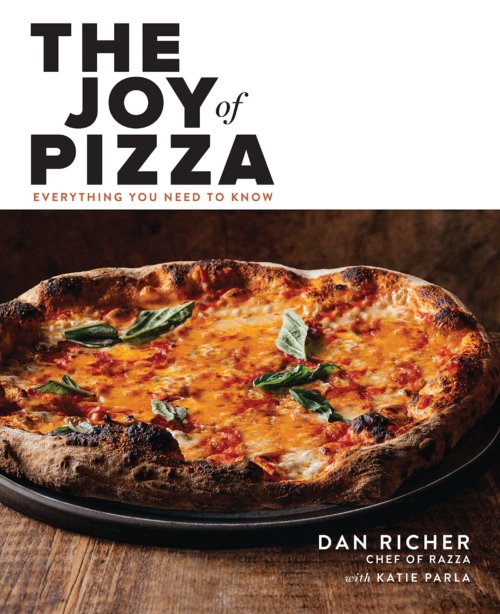


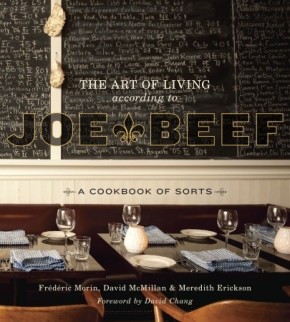

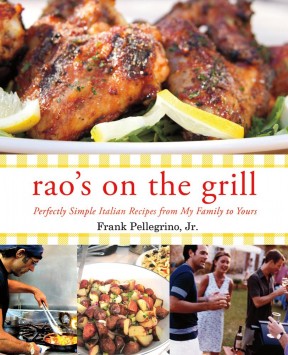
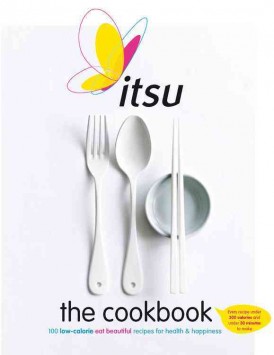

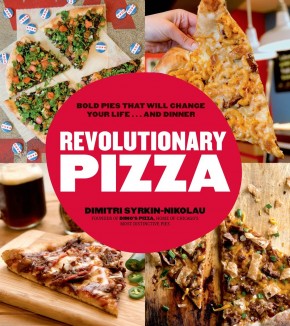
Leave a Reply